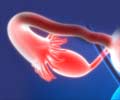The largest analysis of its kind has found that Caucasians are much more likely than people in other racial/ethnic groups to develop a rare bone and soft tissue cancer called Ewing's sarcoma.
The largest analysis of its kind has found that Caucasians are much more likely than people in other racial/ethnic groups to develop a rare bone and soft tissue cancer called Ewing's sarcoma. In addition, among Caucasians with this cancer, men are more likely to die than women. Published in the August 1, 2009 issue of CANCER, a peer-reviewed journal of the American Cancer Society, the study indicates that examining the gender and racial differences related to Ewing's sarcoma could provide a better understanding of the disease and could lead to improved treatments for patients.
Ewing's sarcoma has historically been a difficult cancer to treat, but evolving strategies with various chemotherapy drugs, surgery, and radiation have improved survival. Limited studies have identified risk factors for the disease, although it is clear that there are racial differences in incidence.Patients of various races also differ in how they are affected by the disease and how they respond to treatment. However, no reports from population-based cancer registries have verified these observations and no studies have addressed the potential impact of race on patients' health after they are diagnosed.
To get a better sense of racial differences in a large population of patients with Ewing's sarcoma, researchers led by Dr. Sean Scully of the University of Miami analyzed patient information from the National Cancer Institute's Surveillance, Epidemiology and End Results (SEER) Program, the largest source for cancer statistics in the United States. They identified individuals diagnosed with Ewing's sarcoma from 1973 to 2005 and analyzed various patient- and cancer-related characteristics.
The investigators found that Caucasians had the highest incidence of Ewing's sarcoma (155 cases per 100,000), followed by Asians/Pacific Islanders (82 cases per 100,000) and African Americans (17 cases per 100,000). Those rates indicate that Caucasians are nine times as likely to be diagnosed with the disease than African -Americans.
In addition, the incidence of Ewing's sarcoma has increased significantly over the past three decades in Caucasians. While the analysis identified large differences in incidence rates among races, survival rates were similar. Finally, among Caucasians—but not among other races—women had a much higher likelihood of survival than their male counterparts.
The reasons for these racial and gender differences are not clear. However, "the current study constitutes a significant step towards identification of independent demographic and clinical factors associated with improved survival and clarifies some of the associated controversies in incidence patterns that could impact on the treatment of Ewing's sarcoma," the authors wrote. Additional studies are needed to uncover the causes for racial disparities in incidence and for gender differences in survival.
LIN











